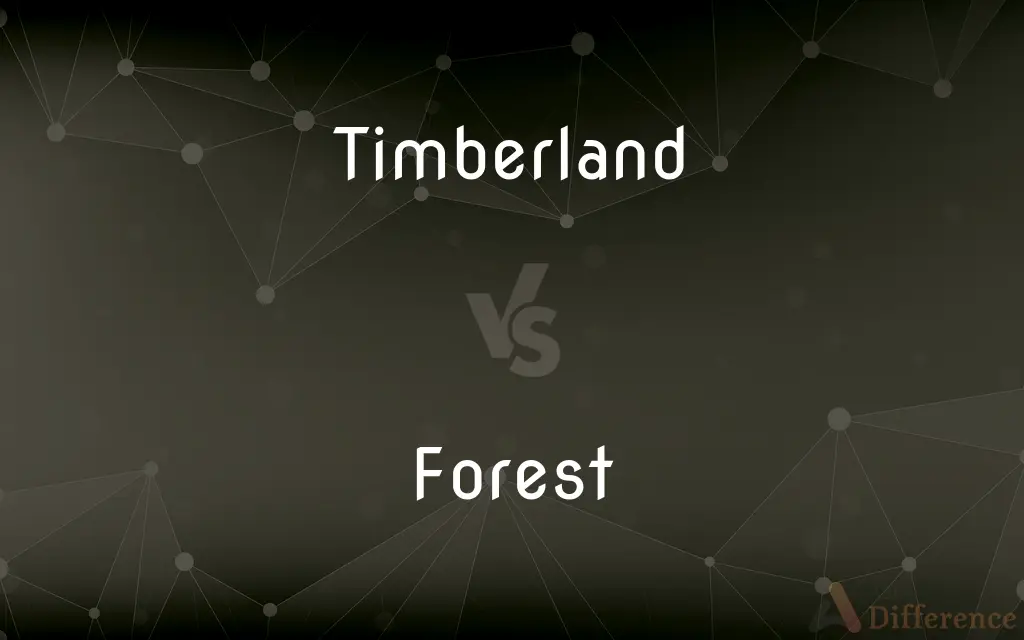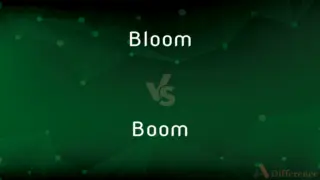Timberland vs. Forest — What's the Difference?
Edited by Tayyaba Rehman — By Fiza Rafique — Updated on May 21, 2024
Timberland refers to land designated for growing and harvesting trees for commercial use, while forest is a large area covered chiefly with trees and underbrush, often maintained for natural conservation.

Difference Between Timberland and Forest
Table of Contents
ADVERTISEMENT
Key Differences
Timberland is primarily focused on the commercial aspect of forestry. This type of land is managed to produce timber, which includes activities like planting, thinning, and harvesting trees. The main goal is the production of wood products, and management practices are typically geared towards optimizing growth and yield of marketable trees. Forests, on the other hand, are extensive areas with diverse ecosystems. They can be natural or planted and are valued for their biodiversity, ecological functions, and recreational opportunities.
Timberland management often involves scientific planning and the use of forestry techniques to maximize economic returns. This includes selective logging, clear-cutting, and replanting cycles designed to sustain continuous production. Conversely, forest management emphasizes conservation and sustainability, focusing on protecting wildlife habitats, maintaining biodiversity, and preserving natural resources for future generations.
While timberland is usually owned by private companies or individuals focused on timber production, forests can be publicly or privately owned and managed for multiple purposes, including conservation, recreation, and ecosystem services. National and state forests, for example, are managed by government agencies with a mandate to balance ecological health and public use.
Timberland's primary product is timber, which is used for construction, paper, and other wood-based products. This commercial focus often means that timberland is subject to economic fluctuations and market demands. Forests, in contrast, provide a wide range of ecosystem services such as carbon sequestration, water filtration, and climate regulation, which are vital for environmental health and are less directly tied to market pressures.
Comparison Chart
Primary Purpose
Commercial timber production
Conservation and ecological balance
ADVERTISEMENT
Management Practices
Intensive forestry techniques
Sustainable and conservation-focused
Ownership
Often privately owned by companies or individuals
Public or private ownership for diverse uses
Economic Focus
Driven by timber market demands
Provides ecosystem services and recreation
Ecological Value
Less emphasis on biodiversity
High emphasis on biodiversity and habitat preservation
Compare with Definitions
Timberland
Land designated for growing trees to be harvested as timber.
The company invested in timberland to secure a steady supply of wood.
Forest
Habitat for wildlife and plant species.
The forest is a protected area to preserve endangered species.
Timberland
Area managed for the production of commercial wood products.
Timberland in the region is a major source of employment.
Forest
Extensive tract of wooded land maintained for conservation.
Forest conservation is crucial for maintaining biodiversity.
Timberland
Land used for forestry practices like planting and harvesting.
The forester walked through the timberland assessing tree growth.
Forest
Natural area providing ecological services and recreation.
The national forest offers numerous trails for public enjoyment.
Timberland
Tract of land covered with marketable trees.
Timberland prices have risen with the demand for lumber.
Forest
A forest is an area of land dominated by trees. Hundreds of definitions of forest are used throughout the world, incorporating factors such as tree density, tree height, land use, legal standing and ecological function.
Timberland
Managed forest area focusing on wood yield.
The timberland was selectively logged to promote sustainable growth.
Forest
A large area covered chiefly with trees and undergrowth
A pine forest
A large tract of forest
Timberland
Forested land, especially land containing timber of commercial value.
Forest
A large number or dense mass of vertical or tangled objects
A forest of high-rise apartments
Timberland
Forested land thought of in terms of its potential and value as timber.
Forest
Cover (land) with forest; plant with trees
A forested hillside
Timberland
Land that is covered with trees and shrubs
Forest
A growth of trees and other plants covering a large area.
Forest
A large number of objects bearing a similarity to such a growth, especially a dense collection of tall objects
A forest of skyscrapers.
Forest
A defined area of land formerly set aside in England as a royal hunting ground.
Forest
To plant trees on or cover with trees.
Forest
A dense uncultivated tract of trees and undergrowth, larger than woods.
Forest
Any dense collection or amount.
A forest of criticism
Forest
(historical) A defined area of land set aside in England as royal hunting ground or for other privileged use; all such areas.
Forest
(graph theory) A graph with no cycles; i.e., a graph made up of trees.
Forest
A group of domains that are managed as a unit.
Forest
The colour forest green.
Forest
(transitive) To cover an area with trees.
Forest
An extensive wood; a large tract of land covered with trees; in the United States, a wood of native growth, or a tract of woodland which has never been cultivated.
Forest
A large extent or precinct of country, generally waste and woody, belonging to the sovereign, set apart for the keeping of game for his use, not inclosed, but distinguished by certain limits, and protected by certain laws, courts, and officers of its own.
Forest
Of or pertaining to a forest; sylvan.
Forest
To cover with trees or wood.
Forest
The trees and other plants in a large densely wooded area
Forest
Land that is covered with trees and shrubs
Forest
Establish a forest on previously unforested land;
Afforest the mountains
Forest
Large area covered chiefly with trees and underbrush.
The forest was home to diverse species of plants and animals.
Forest
Ecosystem characterized by a high density of trees.
They spent the weekend hiking through the dense forest.
Common Curiosities
What defines a forest?
A forest is a large area covered chiefly with trees and underbrush, often maintained for natural conservation.
What are the main goals of timberland management?
The main goals are to maximize economic returns from timber production.
What products come from timberland?
Timberland produces wood products like lumber, paper, and other materials.
Is all timberland considered a forest?
Not necessarily, as timberland is managed primarily for commercial timber production, whereas a forest may be conserved for ecological balance.
Who manages forests?
Forests can be managed by government agencies, private owners, or conservation organizations.
What is timberland?
Timberland is land designated for growing and harvesting trees for commercial use.
Who typically owns timberland?
Timberland is often owned by private companies or individuals focused on timber production.
Can timberland be used for recreation?
Sometimes, but its primary use is for timber production.
How is timberland managed?
Through practices like selective logging, clear-cutting, and replanting cycles.
Do forests have economic value?
Yes, through ecosystem services, recreation, and sometimes sustainable timber harvesting.
What are the main goals of forest management?
The main goals are conservation, biodiversity protection, and providing ecosystem services.
What services do forests provide?
Forests provide ecosystem services such as carbon sequestration, water filtration, and recreational opportunities.
Can forests be commercially exploited?
Yes, but such exploitation is usually balanced with conservation efforts to maintain ecological integrity.
How is forest management different?
Forest management focuses more on sustainability, conservation, and ecological health.
Is timberland always privately owned?
Not always, but it is commonly owned by private entities focused on timber production.
Share Your Discovery

Previous Comparison
Bloom vs. Boom
Next Comparison
Coupling vs. UnionAuthor Spotlight
Written by
Fiza RafiqueFiza Rafique is a skilled content writer at AskDifference.com, where she meticulously refines and enhances written pieces. Drawing from her vast editorial expertise, Fiza ensures clarity, accuracy, and precision in every article. Passionate about language, she continually seeks to elevate the quality of content for readers worldwide.
Edited by
Tayyaba RehmanTayyaba Rehman is a distinguished writer, currently serving as a primary contributor to askdifference.com. As a researcher in semantics and etymology, Tayyaba's passion for the complexity of languages and their distinctions has found a perfect home on the platform. Tayyaba delves into the intricacies of language, distinguishing between commonly confused words and phrases, thereby providing clarity for readers worldwide.
















































